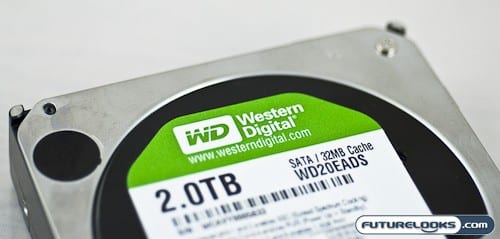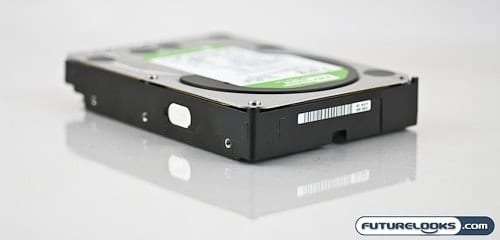A few weeks ago, we reviewed one of Western Digital’s flagship drives, the Western Digital Caviar Black WD1001FALS 1TB SATA hard drive. Like WD’s top end Velociraptors, the drive was engineered and designed for desktop performance with a 7200RPM spindle speed and dual processors to share the load. As a result, it tends to be noisier like its Velociratpor brother. It also consumes more power, like its Velociraptor brother. Today, we’re going to head to the quieter and more eco-friendly side of the Western Digital family.

Western Digital’s Caviar Green series represents drives that are quieter and that use far less power than their high performance counterparts. The high capacity of these drives also makes them ideal for devices that get turned on all day long like Network Attached Storage (NAS) devices or home theatre PCs. Today, we’ll be looking at the largest (and greenest) hard drives currently on the market, the Western Digital Caviar Green 2.0TB (WD20EADS).
Features and Specifications
Just because the Western Digital Green 2.0 TB drive is an Eco Friendly product, it doesn’t mean that it is a low performance product. It just approaches the problem with emphasis on noise and power consumption. WD uses features like Intellipower, Intelliseek, low power spin-up and advanced power technology to tackle the issue of getting performance with less power consumed.

Other features include No Touch ramp load technology and StableTrac (available on this 2.0 TB model) to reduce wear and tear on the four very dense 500GB platters inside the shell. The areal density of the 500GB platters combined with Perpendicular Magnetic Recording (PMR) also gives you performance without a powerplay penalty. Topping this all off is 32MB of cache and a SATA2 interface which gives you a data transfer rate of up to 3 Gb/s which is roughly 300 MB/s. If you simply must have more detailed specifications, you can find them right here. Otherwise, carry on.
The Western Digital Green 2.0 TB drive will set you back about $350 US for the largest drive on the planet as of this review. This is almost enough green to buy four 1TB drives, though you would still easily win the argument of who has the bigger unit if you got one anyway. However, this one drive will consume far less power than two drives, which is the emphasis of the Green series.
System Setup
In order to test our massive 2.0 TB Caviar Green Drive, we assembled a test system using the following components:
- AMD Phenom 9900E 2.6GHz Quad Core CPU (Provided by AMD)
- Asus M3A32-MVP Deluxe/WiFi-AP 790FX Motherboard (Provided by ASUS)
- CORSAIR XMS2 DHX 4GB DDR2-800 Memory Kit (Provided by CORSAIR)
- Western Digital Velociraptor WD3000GLFS Hard Drive (Provided by Western Digital)
- HighSpeedPC Top Deck Tech Station (Provided by HighSpeedPC)
- ANTEC Quattro 1000 Watt Power Supply (Provided by ANTEC)
Our operating system of choice was Windows Vista Premium 64 bit and we’ll be making use of HD Tune Pro for our tests. We’ll also be making direct comparisons between this drive and its very common older sibling, the Western Digital GreenPower 1TB WD10EAVS, which is found in many of Western Digital’s external hard drive products. Let’s get to work.
Power Consumption
The four 500 GB platters of the WD20EADS spun up and topped out at a maximum consumption of 16 Watts. This is much lower than the WD10EAVS at 22 Watts and far lower than that of the extremely popular (but somewhat problematic) Seagate 1TB 7200.11. Spinning up that drive’s 7200RPM platters brings consumption up to 25 Watts immediately.
Once settled into the operating system at boot, the WD20EADS sits at an idle consumption of 5 watts while the WD10EAVS sat at 4 watts. This is likely due to the fact that the WD10EAVS only has three 333GB platters while WD20EADS has to lug around four 500GB ones. In comparison to the Seagate 7200.11 1TB drive, which sits idle at 10 – 11 Watts, the two Western Digital Green drives are merely sipping at the power grid. Since that’s what drives do most of the time, sit around idle, it can be a substantial savings on your power bill over the course of a year and beyond.
During benchmarking, we saw the power consumption of the WD20EADS hold steady at 9 Watts, while the WD10EAVS skipped between 8 – 9 Watts. For comparison, the Seagate 7200.11 1TB uses 12 – 13 Watts under similar conditions.
